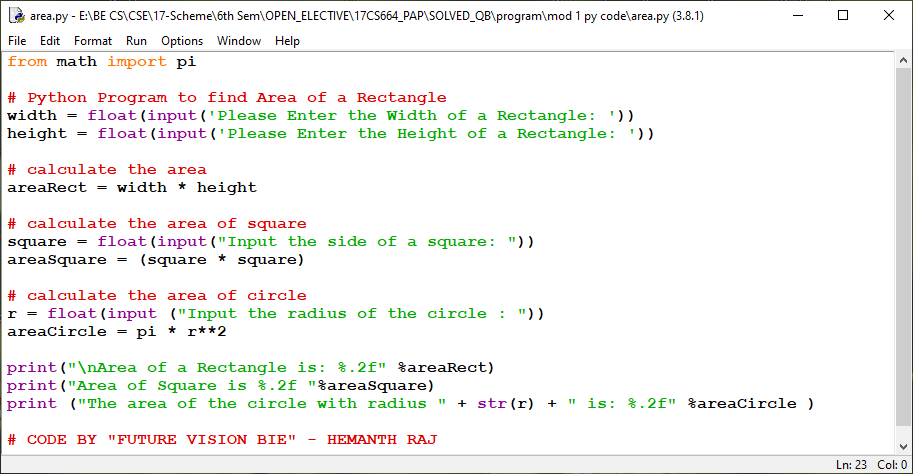NOTE!
Click on MENU to Browse between Subjects...17CS664 - PYTHON APPLICATION PROGRAMMING
Answer Script for Module 1
Solved Previous Year Question Paper
CBCS SCHEME
PYTHON APPLICATION PROGRAMMING
[As per Choice Based Credit System (CBCS) scheme]
(Effective from the academic year 2017 - 2018)
SEMESTER - VI
Subject Code 17CS664
IA Marks 40
Number of Lecture Hours/Week 3
Exam Marks 60
These Questions are being framed for helping the students in the "FINAL Exams" Only
(Remember for Internals the Question Paper is set by your respective teachers).
Questions may be repeated, just to show students how VTU can frame Questions.
- ADMIN
Python provides lots of features that are listed below.
1) Easy to Learn and Use
Python is easy to learn and use. It is developer-friendly and high level programming language.
2) Expressive Language
Python language is more expressive means that it is more understandable and readable.
3) Interpreted Language
Python is an interpreted language i.e. interpreter executes the code line by line at a time. This makes debugging easy and thus suitable for beginners.
4) Cross-platform Language
Python can run equally on different platforms such as Windows, Linux, Unix and Macintosh etc. So, we can say that Python is a portable language.
5) Free and Open Source
Python language is freely available at official web address. The source-code is also available. Therefore, it is open source.
6) Object-Oriented Language
Python supports object oriented language and concepts of classes and objects come into existence.
7) Extensible
It implies that other languages such as C/C++ can be used to compile the code and thus it can be used further in our python code.
8) Large Standard Library
Python has a large and broad library and provides rich set of module and functions for rapid application development.
9) GUI Programming Support
Graphical user interfaces can be developed using Python.
10) Integrated
It can be easily integrated with languages like C, C++, JAVA etc.


Functions that readily comes with Python are called built-in functions.
Python provides built-in functions like print(), etc. but we can also
create your own functions. These functions are known as user defines functions
.
3.1 User defined functions
All the functions that are written by any us comes under the category of user defined functions. Below are the steps for writing user defined functions in Python.
-
In Python,
def
keyword is used to declare user defined functions. - An indented block of statements follows the function name and arguments which contains the body of the function.
Syntax
def function_name():
statements
.
.
Example:


3.2 Parameterized Function with Return value
The function may take arguments(s) also called parameters as input within the opening and closing parentheses, just after the function name followed by a colon.
Syntax:
def function_name(argument1, argument2, ...):
statements
.
.
return <value>
Example 2:


4.1 Conditional Execution:
In order to write useful programs, we almost always need the ability to check conditions and change the behavior of the program accordingly. Conditional statements
give us this ability. The simplest form is the if statement:
if x > 0:
print('x is positive')
The Boolean expression after the if statement is called the condition. We end the if statement with a colon character (:) and the line(s) after the if statement are indented.

If the logical condition is true, then the indented statement gets executed. If the logical condition is false, the indented statement is skipped.
if statements have the same structure as function definitions or for loops. The statement consists of a header line that ends with the colon character (:) followed by an indented block. Statements like this are called compound statements because they stretch across more than one line.
4.2 Alternate Execution:
A second form of the if statement is alternative execution, in which there are two possibilities and the condition determines which one gets executed. The syntax looks like this:
if x%2 == 0 :
print('x is even')
else :
print('x is odd')
If the remainder when x is divided by 2 is 0, then we know that x is even, and the program displays a message to that effect. If the condition is false, the second set of statements is executed.

Since the condition must either be true or false, exactly one of the alternatives will be executed. The alternatives are called branches, because they are branches in the flow of execution.
4.3 Chained Execution:
Sometimes there are more than two possibilities and we need more than two branches. One way to express a computation like that is a chained conditional:
if x < y:
print('x is less than y')
elif x > y:
print('x is greater than y')
else:
print('x and y are equal')
elif is an abbreviation of "else if." Again, exactly one branch will be executed.
There is no limit on the number of elif statements. If there is an else clause, it has to be at the end, but there doesn't have to be one.

Each condition is checked in order. If the first is false, the next is checked, and so on. If one of them is true, the corresponding branch executes, and the statement ends. Even if more than one condition is true, only the first true branch executes.


Below Page NAVIGATION Links are Provided...
All the Questions on Question Bank Is SOLVED

 MENU
MENU

